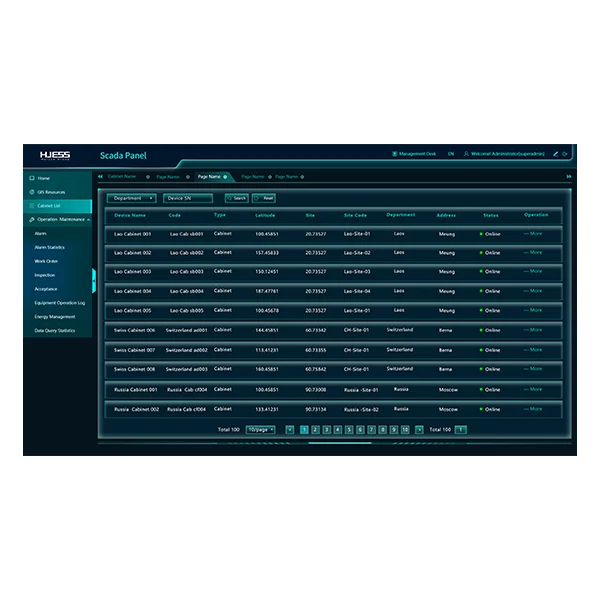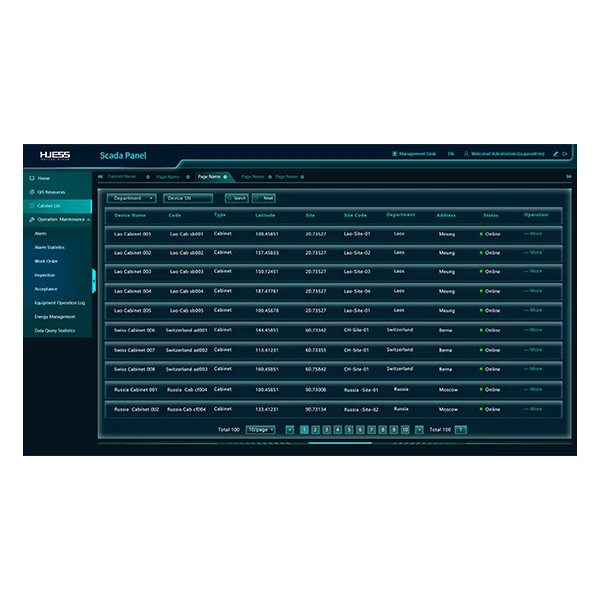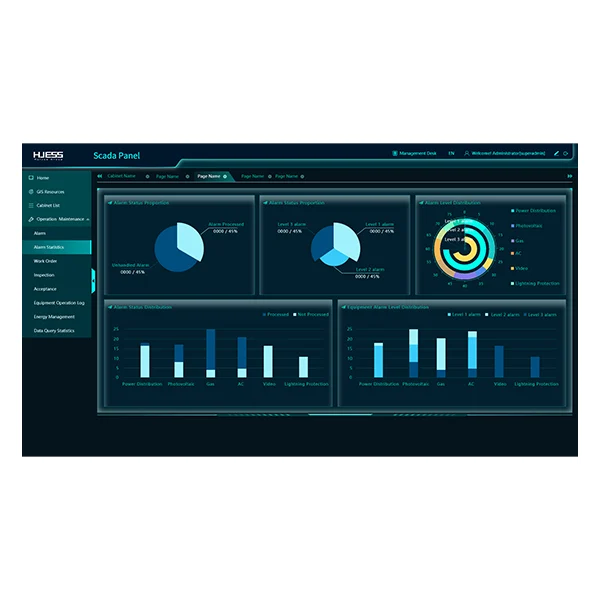2024-12-30
As an advanced intelligent system, the Energy Management System will integrate hardware and software technologies to comprehensively and prudently monitor, control, and optimize energy flow and consumption within the energy system. EMS, through data acquisition, analysis, and decision support technologies, can acquire in real time the status of operation, energy consumption, and environmental conditions to achieve efficient management and optimization of energy.

The importance of an energy management system to an energy storage system is self-evident, and the reflection of its importance is well reflected in the following major aspects:
It also monitors, in real time, the running status of an energy storage system, such as the status of battery charging and discharging, temperature, voltage, and current. The EMS is able to accurately control the energy storage converter for charging/discharging operation to maintain the battery in its best working condition. This refined control strategy helps reduce energy waste and improve energy efficiency.
Based on a strategy related to grid demand, the status, and cost of batteries, the EMS can provide optimum charging/discharging of an energy storage system. Through the EMS, the electric energy is released by an energy storage system during peak hours of power demand and relieves the pressure of the power grid. When there is excess power or the price of electricity is much lower, the energy storage system will be controlled by the EMS to charge and store surplus power. This kind of intelligent energy scheduling and distribution reduces operating costs and creates economic benefits.
The series safety protection in the EMS includes over-temperature protection, overcharge protection, over-discharge protection, and balanced management that effectively prevent damage to batteries or safety accidents. It can monitor the real-time faults of the energy storage system, provide the report of fault diagnosis, and help the maintenance personnel solve the problems in time, so as to ensure the safety and reliability of the energy storage system.
EMS can predict and plan the running state of the energy storage system by means of advanced algorithms and models. For instance, it can predict grid loads and renewable energy generation, through historical data and weather forecast respectively, and then plan an operating strategy for the energy storage system. It improves the overall performance and response speed of the energy storage system due to this intelligent forecasting and planning capability.
With the rapid development of renewable energy and continuous progress in smart grid technology, energy storage technology, as a key means to solve the imbalance of energy supply and demand and ensure the stable operation of power grids, is gradually receiving widespread attention. As the core component of the energy storage system, EMS has become increasingly important. It enables energy transition and sustainable development by optimizing energy scheduling and allocation, improving energy efficiency, and ensuring system safety and reliability.

Both EMS and BMS are used in the management of energy or batteries, but their emphases go in different directions. While the core task of BMS mainly consists of monitoring status, safety protection, and balance control of a pack or several packs to guarantee the safety and performance of the battery pack, on the other hand, EMS is much more concerned with holistic monitoring, controlling, and optimization of the whole energy system involving energy generation, storage, consumption, and scheduling. Both of them are complementary and together can provide a strong guarantee for the energy storage system in stable operation.
Energy management system, EMS, in simple words, has the following major functions:
Monitoring and acquisition: Through sensors and instrumentation equipment, real-time monitoring of energy generation, storage, and consumption in energy storage facilities is made, including the collection of the status of battery charging/discharging, temperature, voltage, current, and other key data.
Data Optimization and Analysis: Advanced technologies for in-depth analysis of the collected data to identify some problems that really exist in an energy system and offer targeting optimization suggestions.
Energy Scheduling and Control: Conceived from real energy demands and a running system for performing intelligent scheduling and energy management in ways that utilize energy more effectively and conservatively.
Fault detection and safety protection Timely detect and alarm the fault situation in the energy storage facility, such as the battery overdischarge, overcharge, temperature abnormal, etc., to ensure the safe operation of the energy storage facility.

Energy management systems are very broadly applied in many industrial fields and areas.
EMS in industrial settings can monitor and optimize the energy use of equipment and energy supply systems. For example, in places like factories, logistics centers, and production lines, EMS can monitor in real time the energy consumption of equipment and thus perform automatic adjustments in energy distribution based on real-time data to reduce energy consumption and lower operation costs.
In commercial buildings, the EMS can monitor and manage energy consumption in order to optimize energy usage for air conditioning, lighting, and other equipment. Through real-time monitoring and analysis of energy consumption data inside a building, the EMS will be able to pinpoint where energy is being wasted and make suggestions for optimization. This reduces energy waste and operating costs.
Application of EMS is very important in facilities like electric vehicle charging stations and charging piles. It can monitor factors such as charge volume, charges, and grid load, thus enabling smart charging and optimization of energy management. By intelligently scheduling charging periods and power levels, EMS will optimize the grid loads while ensuring the EV charging needs.
In the smart home industry, EMS is able to integrate the energy devices including solar panels, heat pumps and smart meters. Equipped with various intelligent algorithms, EMS may make better use of energies, then improve the energy efficiency for the home. As mentioned above, when solar energies are sufficient, by utilizing these energies, smart houses will generate their electricity and be less dependent on traditional electric power systems.
Energy network monitoring and control in cities are also possible with the aid of EMS. By making energy sustainability and efficiency in the city better, it keeps real-time monitoring and regulation over the supply and demand balance of various facilities and resources of energy. For example, when there is a power shortage, the power supply can be automatically shifted to ensure the normal operations of key facilities by an automatically initiated EMS.
It can monitor and dispatch large data centers that house power-consuming equipment like servers and refrigeration units. A data center energy management system, through real-time data center energy consumption data, can locate the source of energy waste and make optimization suggestions for it, therefore upgrading energy efficiency and stability at data centers.
It will enable the integration of renewable sources, such as solar and wind. By storing surplus energy with an energy storage system for release during peak demands, EMS is able to extend the use of renewable energies. This will go a long way in promoting green energy development and less reliance on conventional sources of energy.
In the virtual power plant, the application of EMS is also very important. It operates and optimizes various distributed energy resources such as solar, wind, energy storage, and demand response resources at virtual power plants in real time. By developing appropriate energy trading strategies intelligently, it enables EMS to maximize the economic benefits brought to the virtual power plants and ensure power supply stability and security.
In microgrid applications, EMS can manage multiple energy resources, including battery storage, fuel cells, thermal energy storage, and more. By realizing optimal allocation and autonomous management of energy, EMS can improve energy efficiency and stability of microgrid.
Introduction of advanced algorithms: EMS continuously optimizes the algorithm model, introduces advanced technologies such as machine learning and deep learning, improves the accuracy of prediction, and enhances the efficiency of scheduling. For example, through deep learning algorithms analyzing historical meteorological data, user usage habits, and power grid load changes, the system can automatically adjust the output ratio of the power generation side and energy storage side for efficient use of energy.
Big data and cloud computing: Using big data technology to analyze and mine data in conjunction with the powerful data processing capability of cloud computing, EMS can process and analyze large data in real time and provide more accurate decision-making support for energy management.
Intelligent decision: With the integration of advanced artificial intelligence technologies like natural language processing, image recognition, etc., EMS will be able to make more intelligent decisions. The system can self-regulate the energy scheduling strategy based on real-time data to ensure stability in operation and efficiency in the energy utilization system.
Automate control: it enables the method to have remote monitoring and control over energy equipment using automatic control technology. It will not only reduce the number of human interventions in order to improve the operation efficiency of the energy system but also timely detection and take measures in time to ensure the safety of an energy system.
Multi-system integration: EMS will make more exploration in the in-depth integration with a smart grid, smart city, and other systems. Based on data sharing and coordinating the operation with other intelligent systems, EMS can take more and more energy scheduling and management work in a wider range, thus promoting the regional energy allocation and balance.
Uniform protocols: Industry criteria ensure system interoperability for expandability. The EMS can then easily connect to other energy management systems, power grid dispatch management systems, etc., to achieve more efficient data transmission and control command exchange.
Sustainability and environmental protection
Renewable Energy Optimization: EMS emphasizes dispatching renewable energy through accurate forecasting of the energy supply and demand trend of the future period of time, reduces the use of traditional energy and carbon emissions. Meanwhile, it could dynamically adjust the energy production strategy with climate conditions, light intensity, and other factors to maximize the utilization of renewable energy.
Energy efficiency improvement: The operating status and energy consumption of energy equipment are monitored in real-time, and analysis is performed to provide recommendations for energy efficiency improvement through the EMS. For instance, the adjustment of optimized energy scheduling strategy and equipment operating parameters will reduce energy consumption and emissions, thereby improving energy efficiency.
Visual interface: The intuitive user interface of EMS presents key performance indicators and system status. In this way, the user is able to better understand operation and energy efficiency performance, increasing user satisfaction and engagement.
Personalized customization: EMS performs the work of personalization in energy management solutions and optimization suggestions in accordance with the requirements of users. For example, smart adjustment of operation mode and scheduling strategy of energy equipment according to the user's power consumption habits and needs will make energy management more personalized.
In a word, the innovative direction of EMS covers many aspects: technology integration and upgrading, intelligence and automation, system integration and interoperability, sustainability and environmental protection, user interaction, and experience optimization. The above-mentioned innovative directions will drive EMS to be more effective, intelligent, eco-friendly, and humanized, which would contribute to the building of a green, low-carbon, and sustainable energy system.